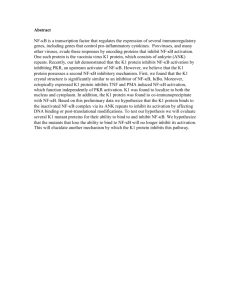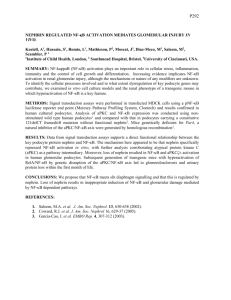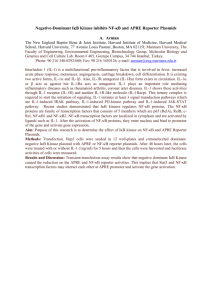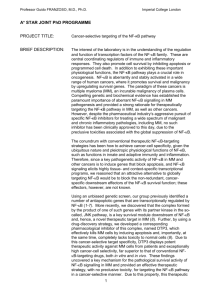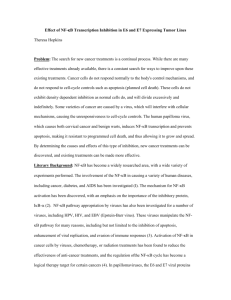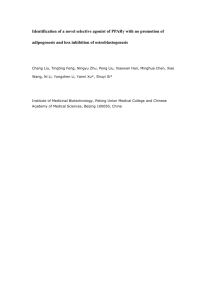SUPPLEMENTARY DATA SUPPLEMENTARY MATERIALS AND
advertisement
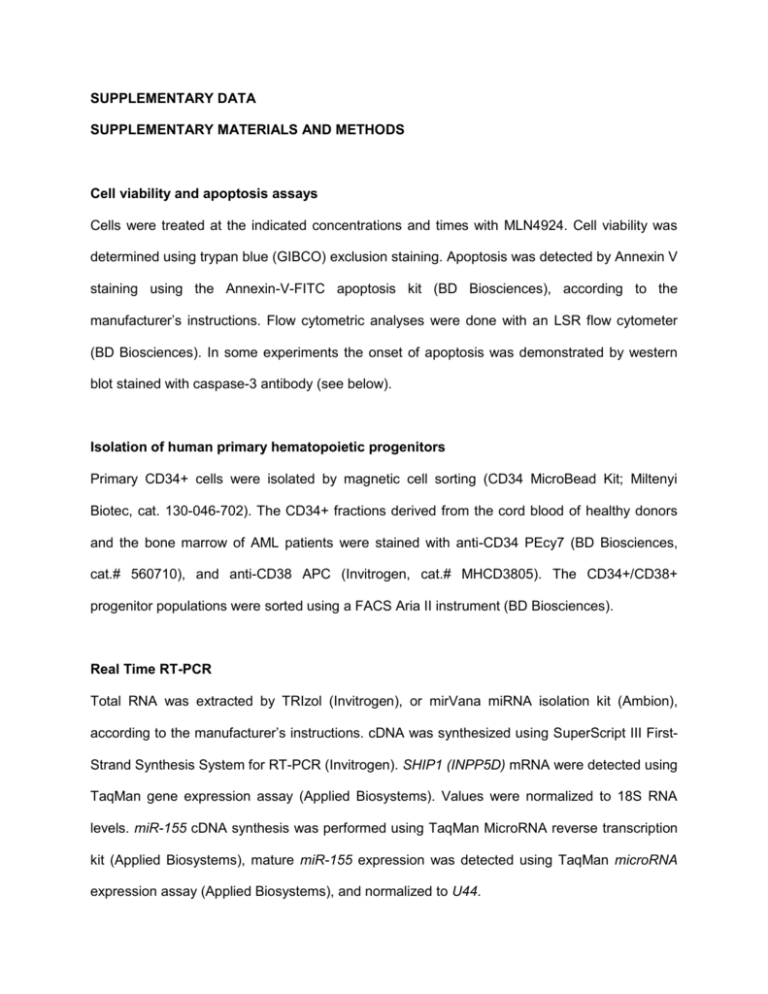
SUPPLEMENTARY DATA SUPPLEMENTARY MATERIALS AND METHODS Cell viability and apoptosis assays Cells were treated at the indicated concentrations and times with MLN4924. Cell viability was determined using trypan blue (GIBCO) exclusion staining. Apoptosis was detected by Annexin V staining using the Annexin-V-FITC apoptosis kit (BD Biosciences), according to the manufacturer’s instructions. Flow cytometric analyses were done with an LSR flow cytometer (BD Biosciences). In some experiments the onset of apoptosis was demonstrated by western blot stained with caspase-3 antibody (see below). Isolation of human primary hematopoietic progenitors Primary CD34+ cells were isolated by magnetic cell sorting (CD34 MicroBead Kit; Miltenyi Biotec, cat. 130-046-702). The CD34+ fractions derived from the cord blood of healthy donors and the bone marrow of AML patients were stained with anti-CD34 PEcy7 (BD Biosciences, cat.# 560710), and anti-CD38 APC (Invitrogen, cat.# MHCD3805). The CD34+/CD38+ progenitor populations were sorted using a FACS Aria II instrument (BD Biosciences). Real Time RT-PCR Total RNA was extracted by TRIzol (Invitrogen), or mirVana miRNA isolation kit (Ambion), according to the manufacturer’s instructions. cDNA was synthesized using SuperScript III FirstStrand Synthesis System for RT-PCR (Invitrogen). SHIP1 (INPP5D) mRNA were detected using TaqMan gene expression assay (Applied Biosystems). Values were normalized to 18S RNA levels. miR-155 cDNA synthesis was performed using TaqMan MicroRNA reverse transcription kit (Applied Biosystems), mature miR-155 expression was detected using TaqMan microRNA expression assay (Applied Biosystems), and normalized to U44. Expression of primiR-155 from mice was detected by Power SyberGreen (Applied Biosystems) according to the manufacturer’s instructions.The primer pairs used were: primiR-155 : 5’ CCTCTGAGTGCTGAAGGCTTGCT 3’; 5’ GAGTCAGTTGGAGGCAAAAACCCC 3’ 18S: 5’ TTCGGAACTGAGGCCATGAT 3’; 5’ TTTCGCTCTGGTCCGTCTTG 3’ Comparative real time qPCR was performed in triplicate and relative expression was calculated using the comparative Ct method. Chromatin immunoprecipitation (ChIP) ChIP assays were performed using the EZ ChIP Assay Kit (Millipore) per manufacturer recommendations. DNA was quantified using qRT-PCR with SYBR green incorporation (Applied Biosystems). The antibody used was: NF-B p65 (Cell Signaling Technology, # 6956). The specific primers utilized for quantification of NF-B p65 enrichment on the miR-155 promoter were: For NF-B binding site 1: 5’-AAAATGCTCCCAAGTTCCTTAACCA-3’ 5’-TGTCAGAATACATGTCAGAGCTGGA-3’ For NF-B binding site 2: 5’-GTTCAACCTAGAATGAGAAATGGGA-3’ 5’-ACGTCCCTCTGCTGGTTACA -3’ Clonogenic assay Clonogenic assays were carried out by plating 1x103 MV4-11 cells, or 2×104 primary blasts in 0.9% MethoCult (StemCell Technologies). Colony numbers were scored 7 or 10 days later, respectively. Cell proliferation assay Cells were plated at 0.5 x 106 cells/ml in 96-well plates and treated for various lengths of time with MLN4924 at concentrations ranging from 100nM to 1µM. Cell proliferation was assessed using the MTS cell proliferation assay (Promega) according to the manufacturer’s protocol. Plasmid constructions miR-155 promoter region from -1783 to +1 was PCR-amplified and cloned between SacI and HindIII sites of pGL4.11. The mutants of NF-B sites in expression vectors were made using the standard “Site-Directed Mutagenesis” method (ref. S1) employing the following primers: NF-B site #1: Forward: GGCAATTTCTTATAGTTCAACCTAGAATGAGAAAACTAGAATTCAGAAAGGCATTGTAGGCA TCTGTAACCAGC Reverse: GCTGGTTACAGATGCCTACAATGCCTTTCTGAATTCTAGTTTTCTCATTCTAGGTTGAACTA TAAGAAATTGCC NF-B site#2: Forward: CCAACCTGAGCCATCTGTAAATTAAGTACTAACTAGTTTCCAGCTCTGACATGTATTCTGAC ATGTAACTGG Reverse: CCAGTTACATGTCAGAATACATGTCAGAGCTGGAAACTAGTTAGTACTTAATTTACAGATGG CTCAGGTTGG PCR products were digested using DpnI restriction enzyme. The mutations were verified by sequence analysis. The NF-B reporter vector, 3xB-Luc, was generated as previously described (ref. S2). Transient transfections and luciferase assay HEK-293T cells were seeded on 24-well plates at 1 x105 cells per well in 0.5 ml of complete growth medium and grown for 24 hrs. Transfections were performed according to manufacturer’s instructions using Lipofectamin 2000 Reagent (Invitrogen; 2μl per reaction), 400 ng firefly luciferase vector containing wild-type, or mutated miR-155 promoter, and 40 ng pRLTK Renilla luciferase vector. After 2hrs, cells were treated with 10ng/ml of phorbol myristoylated acetate (PMA) for 2hrs followed by a 6hr-treatment with MLN4924. Cells were then harvested and lysed in 100 μl Passive Lysis Buffer (PLB). Luciferase activity was measured on 20 μl lysate using Dual Luciferase Assay (Promega). Precursor of miR-155 and scrambled controls were purchased from Applied Biosystems (Cat. numbers AM17100 and AM1711, respectively). miRNAs were introduced into primary AML blasts using siPORT TM NeoFXTM transfection agent (Ambion, Inc.) according to the manufacturer’s instructions. On-Target Plus SMARTpool p65 siRNA and non-targeting oligonucleotides (Dharmacon) were transfected into 293T cells with Lipofectamine 2000 (Life Technologies). Electrophoretic Mobility Shift Assay (EMSA) Nuclear proteins were extracted from MV4-11 or 293T cells using the Nuclear Extraction Kit (Active Motif) according to manufacturer’s instructions. Double-stranded oligonucleotides were radiolabelled with -dCTP-P32 and Klenow. Ten g of nuclear protein extract was incubated with 50,000 cpm of probe in in a 25-µl reaction mixture containing 10 mM HEPES-KOH buffer (pH 7.9), 50 mM KCl, 2.5 mM MgCl2, 1 mM DTT, 10% glycerol, 1 µg acetylated bovine serum albumin, and 1 µg poly(dI-dC). For supershift, 2l of NF-B p65 (Santa Cruz, sc-7151X), or NF- B p50 (Santa Cruz, sc-7178X) antibody was added to each reaction. For competition, 50 ng of unlabeled double stranded oligo was used. The binding reactions were carried out at room temperature for 20 minutes and complexes were resolved on 5% polyacrylamide gels (Criterion TBE, Bio-Rad, cat. 345-0047) and dried gels were exposed to X-ray films. Oligos utilized are described in Supplementary Table S1. Synthetic miR treatment Synthetic antagomiR-155 or antagomiR scramble control (scr) were obtained from Life Technologies (cat.# 4464084 and 4464076, respectively). Preparation of antagomiR-loaded transferin (Tf)-conjugated nanoparticles was described (ref. S6). Primary blast cells were treated by adding 100 nM of Tf-encapsulated nanoparticles. Western Blotting Western blots were performed as previously described (ref.S3). The antibodies used were SHIP-1 (Cell Signaling Technology, #2725), NEDD8 (Cell Signaling Technology, #2754), Caspase-3 (Cell Signaling Technology, #9662), Cleaved Caspase-3 (Cell Signaling Technology, #9664), Phospho Akt (Thr308; Cell Signaling Technology, #9275), p65 (Cell Signaling Technology, #3034), P-Akt (Ser473; Cell Signaling, #4060), Histone H3 (Abcam, #12079), IBα (Cell Signaling Technology, #4814), p-IBα (Ser32; Cell Signaling Technology, #2859, PU.1 (Cell Signaling Technology, #2258), Akt1 (Santa Cruz Biotechnology, sc-377457), c-myc (Santa Cruz Biotechnology, sc-764) and -actin (Santa Cruz Biotechnology, sc-1616). Total cell lysis and cellular fractionation were done using Nuclear Extraction Kit (Active Motif) according to the manufacturer’s instruction. Morphological cell examination. About 104 cells were spun at 400 rpm for 5 min onto glass slides and Wright-Giemsa stained with DiffQuick solutions (Dade Behring). Flow cytometry Cells were stained with anti-human CD14- Pacific Blue™ (Biolegend, #325615), anti-human CD115-APC (Biolegend, #347305), anti-human CD11b-PE (eBioscience, #12-0118-41), antihuman CD11c-FITC (eBioscience, # 11-0116-42), and anti-human CD33-PE-Cy7 (eBioscience, # 25-0338-42). Immunophenotyping was done on a LSR Flow Cytometer (BD Biosciences). Data were analyzed with FlowJo software (Treestar, Inc.). SUPPLEMENTARY REFERENCES S1. Hutchison CA, Phillips S, Edgell MH, Gillam S, Jahnke P, Smith M. Mutagenesis at a specific position in a DNA sequence. J Biol Chem. 1978;253:6551-60. S2. Guttridge DC, Albanese C, Reuther JY, Pestell RG, Baldwin AS. NF-kappaB controls cell growth and differentiation through transcriptional regulation of cyclin D1. Mol Cell Biol. 1999;19:5785-99. S3. Liu S, Wu LC, Pang J, Santhanam R, Schwind S, Wu YZ, et al. Sp1/NFkappaB/HDAC/miR-29b regulatory network in KIT-driven myeloid leukemia. Cancer Cell. 2010;17:333-47. SUPPLEMENTARY FIGURE LEGENDS Supplementary Figure S1. miR-155 expression in AML cell lines (A) Mature miR-155 expression in THP-1, MV4-11, Kasumi-1 and CG-SH cell lines was analyzed by TaqMan method. Results are shown as relative fold change after normalization with U44 and 2Ct, based on triplicate readings of an average of three readings in the same experiments. (B) Mature miR-155 levels were also measured in another FLT3-ITD cell line, MOLM-13, and compared to those in THP-1 cells. Supplementary Figure S2. Expression of miR-155 in normal bone marrow and AML primary blasts: Bone marrow from 5 healthy donors and blasts from 5 AML patients was analyzed for mature miR-155 expression. Results are shown as averaged relative copy numbers after normalization for U44. Error bars indicate SD. Supplementary Figure S3. Constitutive NF-B activity in MV4-11 cells: (A) Nuclear extracts of MV4-11 cells treated with vehicle control (DMSO; veh), or 500 nM MLN4924 were incubated with a radiolabeled oligonucleotide containing the canonical NF-B site from the murine immunoglobulin gene promoter (IgB) and analyzed by EMSA. Complex corresponding to the constitutively active DNA-binding NF-B is indicated by the black arrowhead. NF-B complex was specifically supershifted (white arrowhead) with anti-p65 (lane 3) and anti-p50 (lane 4) antibodies. NF-B binding was diminished by 12 hours of treatment with 500 nM MLN4924 (lane 5). (B) Western blot of the total cell extracts showed that p65 protein expression was not altered by MLN4924. Supplementary Figure S4. MLN4924 inhibits proliferation and induces apoptosis of MV411 AML cells and primary AML patient blasts: (A) MTS assays of FLT3-ITD (MV4-11 and MOLM-13) as well as wt FLT3 (THP-1, Kasumi-1 and CG-SM) cells. (B) The effect of MLN4924 on proliferation of primary blasts from three AML patients was also tested. (C) Induction of apoptosis tested by amount of cleaved caspase-3 using Western blot of protein extracts from MV4-11 cells and AML patient blasts (Patient 1) treated with the indicated concentrations of MLN4924 for 48 hours. Supplementary Figure S5. MLN4924 treatment inhibits neddylation-activating enzyme and its substrate, IB-α, as well as NF-B transcriptional activity (A) NEDD-8-cullins and p-IBα protein expression in cytoplasmic extracts of MV4-11 (upper panel) and blasts from AML patients (lower panel) were detected by Western blot after MLN4924 (300 nM and 500 nM) or vehicle control (veh) treatment for 12 hours. (B) p65 protein levels in nuclear, cytoplasmic and total protein extracts of MV4-11 cells treated with MLN4924 at the indicated concentrations, or vehicle (veh) were tested by Western blot. -actin and Histone H3 were used as loading controls. (C) Luciferase assay showing the transcriptional activity of NF-B of 293T cells transiently co-transfected with NF-B responsive firefly luciferase vector (ref.S5) and TK promoter-driven Renilla luciferase (pRL-TK; Promega). Immediately after transfections, cells were stimulated with 10ng/ml PMA for 2 hours to activate NF-B, followed by 6-hour treatment with 300nM or 500 nM MLN4924, or vehicle control (veh). Transfection with siRNA against p65 (p65 siRNA) was used as a positive control and scramble (Sc) oligo served as a negative control. Triplicate readings were averaged and error bars indicate SD (P<0.01). Supplementary Figure S6. Binding of NF-B to the miR-155 promoter is abrogated by point mutations: Nuclear extracts isolated from untreated MV4-11 cells were tested by EMSA with radiolabelled oligonucleotides containing either B1, or B2 sites from the miR-155 promoter. The binding reactions were carried out in the absence, or presence of cold competitors: wild type (self) or mutant NF-B (mutB1, or mutB2) and the NF-B/DNA binding complexes are indicated by a black arrowhead. Supplementary Figure S7. MLN4924 inhibits NF-B binding to miR-155 promoter in 293T cells stimulated with PMA: Nuclear extracts of 293T cells stimulated with 10ng/ml PMA to activate NF-B in the presence of DMSO (veh) or MLN4924 (100 nM or 300 nM) were tested in EMSA assay using radiolabelled NF-B binding sites from the miR-155 promoter (B1 and B2). NF-B/DNA complexes are pointed out by a black arrowhead. Where indicated, anti-p50 antibody was included in the binding reaction and supershifted bands are marked with a white arrowhead. FP, free probe. Supplementary Figure S8. MLN4924 induces myeloid differentiation of MV4-11 cells: MV4-11 cells were treated with MLN4924 as in Figure 6. The cell surface expression of CD11b, CD11c, and CD33 was determined by flow cytometry on days 6 and 7 of the treatment. Supplementary Figure S9. Low levels of nuclear PU.1 protein are required for antileukemic activity of MLN4924: Murine PU.1-null cell line (503) and its stable line with PU.1 fused to estrogen receptor ligandbinding domain (503/PUER) were cultured in 0.01% DMSO (veh), or 100 nM MLN4924 in the absence of -estradiol for 5 days. For comparison, parental 503 and 503/PUER cells were also treated with -estradiol (-estr.) for the same amount of time. (A) Viable cell counts were determined on day 5 of the treatment by trypan blue exclusion and the cell numbers in DMSO were set to 100%. Each bar shows average of triplicate counts and error bars show SEM. (B) Cell aliquots were analyzed for morphological changes by Wright-Giemsa stained cytospin preparations. (C) Western blot showing PU.1-ER fusion protein levels in nuclear and cytoplasmic fractions of 503 and 503/PUER in the absence of -estradiol (arrow). Supplementary Table S1. List of oligonucleotides used as probes in EMSA Supplementary Table S2. Approximate IC50 of MLN4924 The Inhibition Concentration of MLN4924 that caused 50% of reduction of cell viability in MV411 cell line and patient blasts was measured using MTS assay. Supplementary Table S3. Median Fluorescent Intensities (MFI) of cell surface marker staining Primary AML blasts from Patient 1 were treated in vitro with DMSO, 50 nM or 100 nM MLN4924 for 6 days, stained with the listed antibodies and analyzed by FACS (shown in Figure 6E). MFI values are shown.
